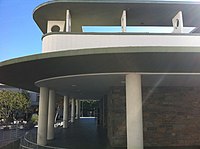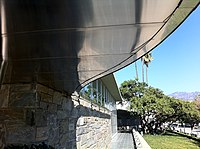| Revision as of 16:34, 4 November 2012 editDoncram (talk | contribs)203,830 edits Undid revision 521325162 by Thundersnow (talk) not excess. pics add to the article, don't go backwards.← Previous edit | Revision as of 06:07, 9 January 2013 edit undoBG19bot (talk | contribs)1,005,055 editsm WP:CHECKWIKI error fix for #61. Punctuation goes before References. Do general fixes if a problem exists. - using AWB (8853)Next edit → | ||
| Line 1: | Line 1: | ||
| {{Infobox |
{{Infobox NRHP | ||
| | name = Bullocks Pasadena | | name = Bullocks Pasadena | ||
| | image = Bullock's Pasadena (looking S).jpg | | image = Bullock's Pasadena (looking S).jpg | ||
| Line 22: | Line 22: | ||
| ==History== | ==History== | ||
| ===Design=== | ===Design=== | ||
| The building was designed by noted Los Angeles architects Wurdeman & Becket, a partnership between ] and ]. In addition to the building itself, the architects oversaw the design and installation of all aspects of the store's interior, from the wallpaper and display cases, to the unique mechanical conveyor system that delivered purchases directly to the parking lot<ref name="PreserveLA">http://www.preservela.com/archives/000395.html</ref> |
The building was designed by noted Los Angeles architects Wurdeman & Becket, a partnership between ] and ]. In addition to the building itself, the architects oversaw the design and installation of all aspects of the store's interior, from the wallpaper and display cases, to the unique mechanical conveyor system that delivered purchases directly to the parking lot.<ref name="PreserveLA">http://www.preservela.com/archives/000395.html</ref> ]This attention to detail reflected the architect's philosophy of "total design," or taking responsibility for master planning, engineering, interiors, fixtures and furnishings, landscape, signage and graphics. The department store was purposely crafted to evoke an atmosphere of a "home" or that of an exclusive ], in keeping with the company president's vision.<ref name="PreserveLA" /> | ||
| The design and merchandising of store were unique and stood in contrast to many older department stores of the time. Bullock's Pasadena was among the first department stores in the country to be located outside of a downtown area and was intended to appeal to the emerging "carriage trade," or those shoppers arriving by automobiles. As such, the store was oriented toward an unheard of {{convert|6|acre|m2|adj=on}} parking lot located behind the structure.<ref name="Conyers">Conyers, Patrick; Phillips, Cedar; and the Pasadena Museum of History''Pasadena: A Business History.''San Francisco, CA: Arcadia Publishing, 2007.</ref> | The design and merchandising of store were unique and stood in contrast to many older department stores of the time. Bullock's Pasadena was among the first department stores in the country to be located outside of a downtown area and was intended to appeal to the emerging "carriage trade," or those shoppers arriving by automobiles. As such, the store was oriented toward an unheard of {{convert|6|acre|m2|adj=on}} parking lot located behind the structure.<ref name="Conyers">Conyers, Patrick; Phillips, Cedar; and the Pasadena Museum of History''Pasadena: A Business History.''San Francisco, CA: Arcadia Publishing, 2007.</ref> | ||
| Line 34: | Line 35: | ||
| The store's promoters touted it as the "store of tomorrow" and Arts and Architecture magazine described it as "one of the world's most modern buildings." In fact, the design was recipient of an AIA Merit Award in 1950.<ref name="Conyers" /> | The store's promoters touted it as the "store of tomorrow" and Arts and Architecture magazine described it as "one of the world's most modern buildings." In fact, the design was recipient of an AIA Merit Award in 1950.<ref name="Conyers" /> | ||
| The store's elegance and prestige was the impetus for a surge in commercial development on both sides of ] following the ]. Previously a residential street bounded by houses, the street was soon dotted with upscale shops, boutiques, national retailers and restaurants and became known as one of the premiere shopping destinations in the ]<ref name="PreserveLA" /> |
The store's elegance and prestige was the impetus for a surge in commercial development on both sides of ] following the ]. Previously a residential street bounded by houses, the street was soon dotted with upscale shops, boutiques, national retailers and restaurants and became known as one of the premiere shopping destinations in the ].<ref name="PreserveLA" /> | ||
| ===Decline=== | ===Decline=== | ||
| The South Lake Avenue shopping district, in which Bullock's Pasadena was a major player, started to lose its luster in the late 1980s. While Pasadena's once-seedy ] district was reborn as a trendy shopping and entertainment district, once-proud South Lake Avenue lost much of its distinction<ref>Hayes, Elizabeth (March 2, 1998). "Macy's out to revitalize Pasadena's South Lake Avenue." Los Angeles Business Journal. http://www.allbusiness.com/sales/672651-1.html. Retrieved 2010-09-17.</ref> |
The South Lake Avenue shopping district, in which Bullock's Pasadena was a major player, started to lose its luster in the late 1980s. While Pasadena's once-seedy ] district was reborn as a trendy shopping and entertainment district, once-proud South Lake Avenue lost much of its distinction.<ref>Hayes, Elizabeth (March 2, 1998). "Macy's out to revitalize Pasadena's South Lake Avenue." Los Angeles Business Journal. http://www.allbusiness.com/sales/672651-1.html. Retrieved 2010-09-17.</ref> | ||
| ===Current use of building=== | ===Current use of building=== | ||
Revision as of 06:07, 9 January 2013
United States historic place| Bullocks Pasadena | |
| U.S. National Register of Historic Places | |
 Bullock's Pasadena from the street Bullock's Pasadena from the street | |
| Location | 401 S. Lake Ave. Pasadena, California, United States |
|---|---|
| Built | 1944 |
| Architect | Wurdeman and Becket |
| Architectural style | Streamline Moderne Art Deco |
| NRHP reference No. | 96000776 |
| Added to NRHP | July 12, 1996 |
Bullock's Pasadena, located at 401 S. Lake Ave. in Pasadena, California, is a 240,000-square foot (21 368 m²) Streamline Moderne Art Deco architectural style building now in use as a Macy's department store.
History
Design
The building was designed by noted Los Angeles architects Wurdeman & Becket, a partnership between Welton Becket and Walter Wurdemen. In addition to the building itself, the architects oversaw the design and installation of all aspects of the store's interior, from the wallpaper and display cases, to the unique mechanical conveyor system that delivered purchases directly to the parking lot.

This attention to detail reflected the architect's philosophy of "total design," or taking responsibility for master planning, engineering, interiors, fixtures and furnishings, landscape, signage and graphics. The department store was purposely crafted to evoke an atmosphere of a "home" or that of an exclusive country club, in keeping with the company president's vision.
The design and merchandising of store were unique and stood in contrast to many older department stores of the time. Bullock's Pasadena was among the first department stores in the country to be located outside of a downtown area and was intended to appeal to the emerging "carriage trade," or those shoppers arriving by automobiles. As such, the store was oriented toward an unheard of 6-acre (24,000 m) parking lot located behind the structure.

Notability
The store's promoters touted it as the "store of tomorrow" and Arts and Architecture magazine described it as "one of the world's most modern buildings." In fact, the design was recipient of an AIA Merit Award in 1950.
The store's elegance and prestige was the impetus for a surge in commercial development on both sides of South Lake Avenue following the Second World War. Previously a residential street bounded by houses, the street was soon dotted with upscale shops, boutiques, national retailers and restaurants and became known as one of the premiere shopping destinations in the San Gabriel Valley.
Decline
The South Lake Avenue shopping district, in which Bullock's Pasadena was a major player, started to lose its luster in the late 1980s. While Pasadena's once-seedy Old Town district was reborn as a trendy shopping and entertainment district, once-proud South Lake Avenue lost much of its distinction.
Current use of building
On July 12, 1996, the building was listed in the National Register of Historic Places as No. 96000776. In May 2000, the city of Pasadena's Design Review Board granted approval for a redevelopment of the building as part of a new shopping area called "The Shops on Lake Avenue," a $33 million project, featuring specialty shops, 27,000 square feet (2,500 m) of new restaurants and a new 300-space-parking garage, increasing parking capacity to nearly 1,200 spaces. Developed by Cleveland, Ohio-based Forest City Development California, Inc. and owned by Federated Department Stores, the project opened in the spring of 2002.
See also
References
- ^ http://www.preservela.com/archives/000395.html
- ^ Conyers, Patrick; Phillips, Cedar; and the Pasadena Museum of HistoryPasadena: A Business History.San Francisco, CA: Arcadia Publishing, 2007.
- Hayes, Elizabeth (March 2, 1998). "Macy's out to revitalize Pasadena's South Lake Avenue." Los Angeles Business Journal. http://www.allbusiness.com/sales/672651-1.html. Retrieved 2010-09-17.
External links
| U.S. National Register of Historic Places | |
|---|---|
| Topics | |
| Lists by state |
|
| Lists by insular areas | |
| Lists by associated state | |
| Other areas | |
| Related | |
| Store conversions to Macy's and predecessors | |||||||||||||
|---|---|---|---|---|---|---|---|---|---|---|---|---|---|
| 2006 |
| ||||||||||||
| 2005 |
| ||||||||||||
| 1996-2001 |
| ||||||||||||
| 1947-1995 |
| ||||||||||||
- Art Deco architecture in California
- Streamline Moderne architecture in California
- Defunct department stores of the United States
- Historic department store buildings in the United States
- National Register of Historic Places in Pasadena, California
- Commercial buildings on the National Register of Historic Places in California
- History of Los Angeles, California
- Towers in California